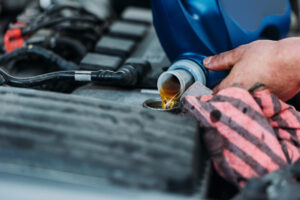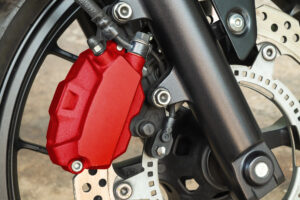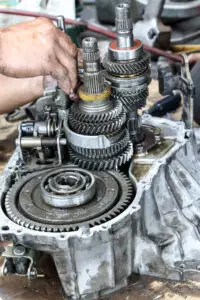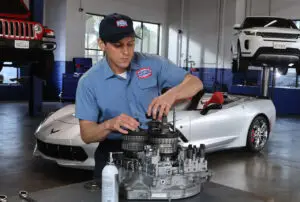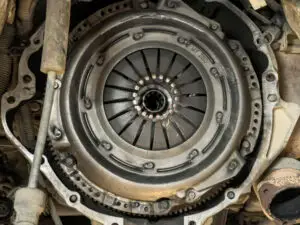The key to extending the life of your transmission is the right preventative care. Everything from regular services by a professional mechanic to at-home care and healthy driving habits can impact the overall operation of your transmission. By keeping up with these tips, you’ll enjoy better performance each time you drive and keep your car running smoothly for years to come.
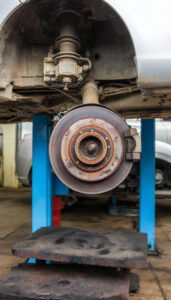 Fill in Your Calendar with These Preventative Care Tips
Fill in Your Calendar with These Preventative Care Tips
Regular visits to a professional mechanic and the right at-home car care together will help prevent avoidable wear or damage to your transmission and other essential components. Transmission fluid changes, inspections, and cooling system services all help keep the system healthy and running efficiently, extending its lifespan.
Check Your Transmission Fluid Every Few Months
Most vehicles have a transmission dipstick that can be used to check the fluid’s level and condition. Follow the same steps you would when checking your engine oil: ensure the engine is cool, pull out the dipstick, wipe it clean with a paper towel, reinsert fully, then remove it again and check where the fluid sits relative to max and min lines. Do this every few months to stay ahead of issues that can present as low, thickened, or burnt transmission fluid.
Have Your Transmission Fluid & Filter Changed Every Few Years
Because transmission fluid plays such an important role in the system’s operation, keeping up with related maintenance will help maintain efficiency and prevent wear. Plan to have your transmission fluid replaced or flushed every five years or 50,000 miles, though the exact timeframe depends on your car’s make and model, as well as your driving habits. The transmission filter should be replaced at the same time to help prevent buildup of contaminants and allow for proper fluid flow.
Schedule Annual Transmission Inspections
Keeping an eye on your transmission at home is beneficial but not a replacement for having regular inspections done by a professional mechanic. During each inspection, your mechanic can assess the overall operation of your transmission, helping catch faulty components before they cause more serious problems on the road. A stuck solenoid can make it difficult to shift gears. A clogged transmission filter can prevent easy fluid flow and speed up wear in the system. Scheduling annual inspections allow your mechanic to catch these and other problems sooner rather than later.
Schedule Cooling System Services Every Two Years
It’s just as important to keep up with regular maintenance on systems related to the transmission. Not only does the cooling system help moderate engine temperature, but it also helps prevent overheating in the transmission. Every few years, coolant should be replaced. The system should also be inspected every year to check for leaks or faulty components. If coolant becomes too low or crucial components like the radiator wear out, heat won’t be properly drawn away from the engine and transmission.
Focus on the Right Driving Habits for Your Transmission’s Health
Believe it or not, your driving habits play a large role in keeping your transmission healthy and extending its lifespan. Each time you sit behind the wheel, focus on these few tips to help prevent avoidable wear, tear, and damage. You’ll save money in the long run and help keep your transmission running smoothly.
Take it Easy Until Your Car Fully Warms Up
Especially during the winter, though it’s helpful in any season, avoid aggressive acceleration and high speeds until your car is fully warmed up. Until systems like the engine and transmission reach their typical operating temperature, fluids are thicker and components are less lubricated, putting them at higher risk of damage. In freezing temperatures, you’ll likely notice a lack of power when you first drive off — once your car seems to regain the power you expect, you’re safe to accelerate to higher speeds.
Avoid Shifting Gears While Your Car is Moving
Do you typically shift out of reverse while your car is still moving when backing out of a parking spot? You may be causing damage to your transmission. Shifting in and out of reverse can put the most strain on your transmission because you’re flipping the direction of motion. While doing this from time to time won’t suddenly cause serious problems, regularly shifting an automatic transmission while the car is moving will cause gradual wear that adds up over time.
Be Careful About Towing or Hauling Heavy Loads
Each vehicle is built to carry up to a certain amount of weight. Check your owner’s manual for your car’s specific recommendations and avoid maxing them out. The more weight you’re towing or hauling, the more strain is put on the transmission, engine, and other important systems. You may find you end up dealing with more frequent transmission repairs and decreased performance over time.
Always Use Your Parking Brake
You may think it’s only important when parking on an incline, but anytime you forget to engage the parking brake risks increased wear on your transmission. Without that brake engaged, it’s up to the transmission to keep your vehicle stationary, putting more strain on a system that’s costly to repair. You’ll risk damaged or worn gears that impact your car’s performance and will bring you to a mechanic more often, ultimately shortening the life of your transmission.
Give Your Transmission a Long Life. Visit Your Local AAMCO.
Trust the transmission experts at your local AAMCO Chicagoland. Whether it’s time for routine maintenance or you’ve caught signs of a transmission problem, we’re here to help with diagnostics, repairs, and any service in between. You’ll drive away confident in your car’s condition and performance. Schedule your appointment with us today!

